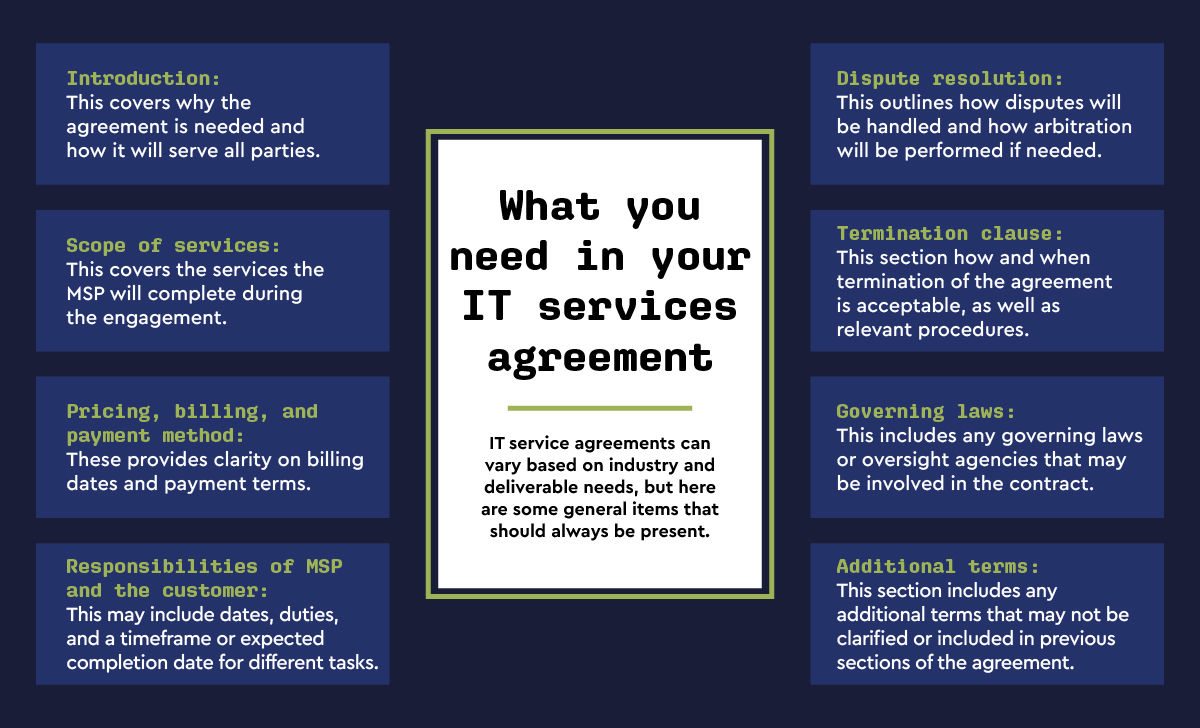Let’s say you’ve found what appears to be the perfect client for your MSP business, and the partnership goes off to a great start. Three months later, this dream client is frustrated because they had a different set of expectations regarding scope and noncompete clauses from you. Now you have to struggle to appease them while also keeping the partnership profitable. How do you avoid such a delicate situation?
You’ll need to write a strong IT services agreement, one that goes beyond the basic sections such as payment terms and project scope. The writing process starts by identifying who your client is, what their industry or vertical sells and provides, and how you can provide the highest quality services at a fair compensation level.
The most effective IT services agreements are clear, concise, and include certain critical sections, as well as allowing room for customization for each situation. Let’s look into how to create such a document.
What is an IT services agreement?
An IT services agreement is a contract between a company and a managed IT services provider. The agreement typically outlines terms, pricing, and duties each party will be assigned and perform throughout the engagement.
Common examples of when an IT service agreement is used include:
- Application management and network security
- Cloud/network maintenance and data backup
- Entire end-to-end IT services and infrastructure monitoring
How IT service agreements help MSPs
So, with this in mind, what are the benefits for MSPs when it comes to IT service agreements? At the core, it’s about reducing ambiguity, so both parties know what is expected of each other.
More concrete ways that IT service agreements help MSPs include:
- Defining the scope of services: IT service agreements clearly describe the duties of each party that need to be carried out. This may include language describing that the MSP is responsible for a specific uptime percentage. Included in the scope of work may also be the data/infrastructure/networks the customer needs to provide or give the MSP access to so that the MSP can carry out its duties effectively.
- Clarity on pricing and billing: This is essential as it eliminates potential issues or arguments that may revolve around how a particular service or engagement is billed or charged to a customer’s account.
- Dispute resolution: If a dispute arises, the agreement should have appropriate language detailing how each party will come together to resolve any conflict. If there are disagreements or contention over aspects not explicitly covered in the IT services agreement itself, this section will help with the steps both parties need to take.
A strong agreement makes for a more efficient and effective relationship with your clients. For additional ways to overcome operational roadblocks and improve your profitability, check out our eBook, How ConnectWise Can Boost Your MSP’s Profitability.
Components of an IT service agreement
If you’re looking to build a comprehensive IT services agreement template, there are a few baseline components you will always need. Granted, you may see additional addendums or sections depending on a particular industry or vertical. Including the fundamental sections below is key to drafting an ironclad IT services agreement, though.
- Introduction: This section outlines the reason for the agreement and how it will serve each party’s needs.
- Scope of services: This section details which services the MSP will complete during the engagement. Any additional items usually need to be added in an addendum or separate contract, which is agreed to by both parties in writing. In addition, this section covers anything explicitly not included to avoid ambiguity.
- Pricing, billing, and payment method: This section provides clarity on billing dates, payment terms, and how payment will be furnished.
- Responsibilities of MSP and the customer: This section’s goal is to eliminate confusion and pave a path forward for each party to follow as the engagement begins. This may include dates, duties, and a timeframe or expected completion date for various engagement periods.
- Dispute resolution: Disputes are more common than many novice MSPs believe. It’s required for IT services agreements to include a section outlining how disputes will be handled and, in the event of an impasse, who will oversee the arbitration of any lingering issues.
- Termination clause: This section covers how and when termination of the agreement is acceptable and what procedures need to be followed to do so.
- Governing laws: It is necessary to include any governing laws (such as the Federal Trade Commission Act or the Federal Arbitration Act) or oversight agencies that may be involved in the contract. This section also includes the name of any jurisdiction and any laws that may apply in the specific jurisdiction as they relate to the engagement.
- Additional terms: This section includes any additional terms that may not be clarified or included in previous sections of the agreement. Common items you’ll likely find in an additional terms section include confidentiality, non-solicitation, and noncompete clauses, among others.

Writing an IT services agreement: step-by-step
Now that you have the basics, here are step-by-step instructions to help you begin writing your IT services agreement. It is important to have a legal professional review your plan and process to make sure there aren’t any additional steps or components you are missing.
To write your next IT services agreement, follow these steps:
- Identify and clarify the parties involved: Your IT services agreement should identify each party’s details, location, and contact information.
- Write down the agreement’s scope: Include the scope of work and responsibilities of each party, including any specific projects or assignments that are key to completing the engagement’s objectives.
- Include a timetable for deliverables: Propose a plan and project schedule that lists deliverables and their expected delivery dates.
- Don’t forget to include compensation details: The IT services agreement should include how the MSP will be compensated and what payment methods will be acceptable. Also include the payment dates and any additional payment methods that can be used in the case of a payment dispute or error.
- Do a proper legal review: it is important to have your agreement reviewed by an attorney in the jurisdictions that oversee the agreement to identify any legal issues with the document.
Qualities of a strong IT services agreement
A strong IT services agreement isn’t just focused on being clear and concise (or legally binding). You will want to consider what serves you (the MSP) and what would be most beneficial and easy for your customer to comply with.
Strong IT service agreements include the following qualities:
- Concise: a strong IT services agreement is often so explicit that it often leaves no room for debate or further discussion.
- Easy to read: an agreement that is easy to read helps each party to grasp detailed sections by avoiding irrelevant information and excessive verbiage.
- Conforms to industry laws/regulations: the agreement should conform to any norms in that industry or jurisdiction.
Move your organization’s needle faster with data-driven insights
ConnectWise's Business Management solutions are designed to deliver the tools and data you need to simplify, manage, and grow your MSP. Watch a demo today to learn how you can boost your organization’s efficiency and productivity.















